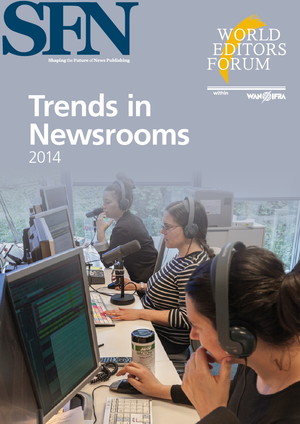Trends in Newsrooms 2014
Trends in Newsrooms 2014

Price
- For non-members: 150 EUR
- For WAN-IFRA members: Free
Download
Employees of WAN-IFRA member organizations can download the report free of charge here, as a membership benefit:
(Note: You do not need your log-in – just your e-mail address.)
Attention non-members: Click here to purchase the report.
Not yet a member? Learn more about WAN-IFRA membership.
Summary
From the foreword, by Erik Bjerager, President, World Editors Forum:
The past year has been a defining one for newsrooms. Since publication of the 2013 Trends in Newsrooms report, the realities, reach, infinite possibilities and, in particular, the risks of the digital age have becoming ever more apparent.
For editors and journalists, this has been both good and bad news. The exposé of the extent of state surveillance through Edward Snowden’s leaks sparked stellar investigative journalism and unprecedented global collaboration between publications and editors.
But the consequences for the way we practice our craft and communicate with sources are significant. Further at risk is public trust in journalism and hard-won press freedoms. Worrying, too, is that the new stresses have come in established democracies whose behaviour so often leads change in regards to press freedom and media development internationally.
The relentless advances in digital technology continue to redefine the newsroom. They affect the way we organise ourselves, engage with audiences, find and verify increasingly diverse content and tell our stories.
Despite all the change, the tipping towards the digital first environment has shown how many practices need urgent revisiting, ethical codes need updating and new skills need to be introduced to allow news producers to remain competitive and relevant. The result is a unique space for creation, innovation and reinvention.
The trends the World Editors Forum has identified are based on observations of emerging and shifting newsroom practices around the globe, and an analysis of original interviews conducted with over 30 editors, senior journalists and editorial strategists from more than a dozen countries (Germany, Italy, USA, U.K., Australia, South Africa, Botswana, Kenya, Indonesia, India, Ukraine and Argentina) in 2014.
They have been framed by compelling interviews with five top journalism “thought leaders.”
Janine Gibson, The Guardian’s US editor and incoming Editor-in-Chief of the global online site, will wake you up to the need for “very live, very deep and very revolutionary” journalism, along with the effects of the Snowden phenomenon. Michael Maness from The Knight Foundation issues a sharp critique of the absence of innovation within legacy newsrooms - which should signal opportunity. Joseph Odindo, Group Editorial Director of Nation Media Group discusses the dynamics of the fast-changing African newsroom. Vivian Schiller, Head of News at Twitter, tells us about the platform as a site for breaking news and improving verification techniques. And The New York Times’ Public Editor Margaret Sullivan will alert you to the impact of real-time audience engagement on editorial management.
This is a must-read publication from the World Editors Forum and we look forward to continuing the conversation about its contents with you online.
- Date:
- 2014-05-21
- Language:
- English
- Type:
- WPT/WEF Trends Report
- Number:
- 1
- Author:
- World Editors Forum
Contact information

Dean Roper
Director of Insights, Editor-in-Chief
WAN-IFRA
| Frankfurt am Main,
Germany
Phone: ++49-69-240063-261
E-Mail: dean.roper@wan-ifra.org


